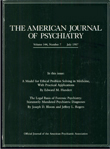Dr. Mundo and Colleagues Reply
To the Editor: Most psychiatric disorders, including OCD and autism, are defined as complex because of the heterogeneity of the phenotype and because of their unclear etiology. For these disorders, is likely that several factors (genetic and nongenetic) interact at the level of pathogenesis.
The involvement of the 5-HT1Dβ receptor in the pathogenesis of both OCD and autism has been suggested by challenge studies involving the acute administration of the selective agonist sumatriptan. This compound has been found to worsen OCD symptoms in OCD patients (1) and repetitive behaviors (rated by means of a compulsion scale) in adult autistic patients (Hollander et al., 2000). In our recent study, we found that the G variant of the G861C polymorphism of the 5-HT1Dβ receptor gene was significantly associated with the diagnosis of OCD and that the estimate of the increased risk conferred by the presence of the G variant was about five.
However, both OCD and autism are likely to be caused by more than one gene and by environmental factors as well, and it is not possible to know the magnitude of the specific genetic contribution to the total risk. Thus, this estimate should be considered suggestive of an effect but not a definitive assessment of the risk, as it would be in the case of noncomplex disorders with Mendelian transmission (2).
Moreover, considering also the heterogeneity of the OCD phenotype, pointed out by epidemiological, biological, clinical, and pharmacological studies as well as the nonspecificity of symptoms in OCD and autism, it appears to be more reasonable in genetic studies of these complex disorders to investigate genes that may be responsible not for a (heterogeneous) diagnostic category but rather for more homogeneous phenotypes.
The hypothesis derived in the article by Hollander and colleagues (Hollander et al., 2000) that serotonin, and particularly the 5-HT1Dβ receptor, plays an important role in repetitive behaviors across disorders may be correct and may represent a valid approach for relating phenotypes to neurobiology beyond the diagnoses. However, evidence that repetitive behaviors have a more homogeneous origin than OCD remains uncertain.
Alternative phenotypes for investigation in genetic studies for psychiatric disorders might include course specifiers, functioning patterns, or response to medication. The new strategies now available for the consideration of quantitative phenotypes that are an alternative to diagnosis in family-based association studies (3) seem the most appropriate procedures for addressing these issues and represent the future of our research in the genetics of OCD and related disorders.
1. Gross R, Sasson Y, Chopra M, Zohar J: Biological models of obsessive-compulsive disorder: the serotonin hypothesis, in Obsessive-Compulsive Disorder: Theory, Research and Treatment. Edited by Swinson RP, Antony MM, Rachman S, Richter MA. New York, Guilford Press, 1998, pp 147–148Google Scholar
2. Risch N, Merikangas K: The future of genetic studies of complex human diseases. Science 1996; 273:1516–1517Google Scholar
3. Allison DB: Transmission-disequilibrium tests for quantitative traits. Am J Hum Genet 1997; 60:676–690; erratum, 60:1571Google Scholar



